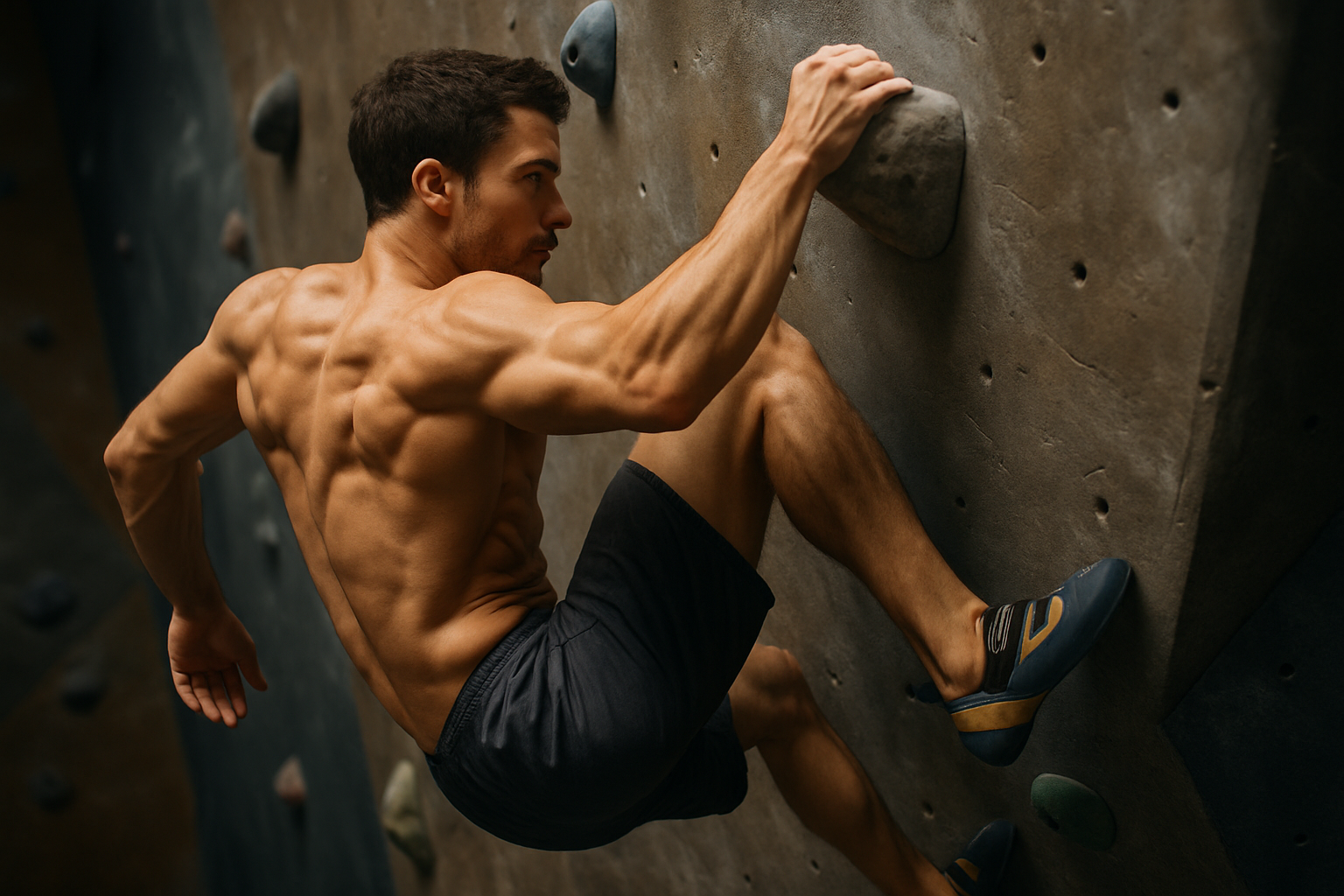Biomechanics of Bouldering: Unlocking the Secrets of Vertical Mastery
The world of climbing has experienced a surge in popularity, with bouldering emerging as a thrilling subset that challenges both body and mind. This discipline, characterized by short, intense routes on low rock formations or artificial walls without ropes, demands a unique blend of strength, flexibility, and problem-solving skills. As climbers navigate these vertical puzzles, they unknowingly engage in a complex dance of biomechanics, pushing the limits of human physicality and movement efficiency.

The Foundations of Bouldering Biomechanics
At its core, bouldering is a study in the application of force against gravity. The human body, a complex system of levers and pulleys, must work in harmony to overcome the constant downward pull while progressing upward. The key to successful bouldering lies in understanding and optimizing the biomechanical principles that govern movement on the wall.
The center of mass (COM) plays a pivotal role in bouldering biomechanics. Climbers must constantly adjust their COM to maintain balance and generate the necessary force for upward movement. This involves a delicate interplay between the body’s various segments, with the core muscles acting as the central stabilizer. As climbers progress through a route, they must continuously shift their COM to optimal positions, allowing for efficient weight transfer and movement execution.
Joint angles and muscle activation patterns are equally critical in bouldering biomechanics. The shoulders, elbows, hips, and knees work in concert to create the precise movements required for successful ascents. Research has shown that expert climbers exhibit greater joint mobility and more efficient muscle recruitment patterns compared to novices, highlighting the importance of biomechanical optimization in skill development.
The Power of Grip: Understanding Contact Forces
In bouldering, the hands serve as the primary point of contact with the climbing surface, making grip strength and technique paramount. The biomechanics of grip in bouldering are far more complex than simply hanging onto holds. Climbers must employ various grip types, each with its own biomechanical considerations.
The crimp grip, characterized by hyperextension of the distal interphalangeal joints, generates significant force but also places immense stress on the finger tendons. Studies have shown that elite climbers can generate forces up to 500% of their body weight through their fingertips when using this grip. However, the biomechanical stress associated with crimping also increases the risk of injury, particularly to the A2 pulley.
In contrast, the open-hand grip distributes force more evenly across the fingers and palm, reducing stress on individual structures. This grip type, while generally less powerful than crimping, allows for greater endurance and reduced injury risk. Understanding the biomechanics of different grip types enables climbers to make informed decisions about when to employ each technique, balancing performance with long-term joint health.
Dynamic Movement: The Art of Controlled Chaos
While static movements form the foundation of bouldering technique, dynamic movements often define the most challenging and spectacular ascents. These explosive movements, characterized by momentary loss of contact with the wall, require precise biomechanical coordination to execute successfully.
The biomechanics of dynamic movements in bouldering involve rapid force generation through the legs, core, and arms, coupled with precise timing and body positioning. Research has shown that elite climbers can generate vertical velocities of up to 2.5 meters per second during dynamic moves, highlighting the explosive nature of these techniques.
Key to successful dynamic movements is the concept of pre-tension. Before initiating the move, climbers must engage their muscles to create a coiled spring effect, storing potential energy that can be rapidly released. This pre-tension also serves to stabilize the body, allowing for more accurate targeting of the intended hold.
The moment of release in a dynamic move represents a critical point in the biomechanical sequence. Climbers must coordinate the extension of their joints to generate maximum force while maintaining body control. Studies using motion capture technology have revealed that expert climbers exhibit smoother, more efficient movement patterns during dynamic moves compared to novices, underscoring the importance of refined biomechanics in advanced bouldering.
The Role of Footwork in Bouldering Biomechanics
While the upper body often takes center stage in discussions of climbing technique, the feet play an equally crucial role in bouldering biomechanics. Proper footwork is essential for weight distribution, balance, and force generation, forming the foundation upon which all other movements are built.
The biomechanics of foot placement in bouldering involve precise control of the ankle joint and intrinsic foot muscles. Climbers must be able to modulate the pressure and orientation of their feet on holds of varying sizes and angles. Research has shown that expert climbers exhibit greater ankle mobility and foot strength compared to novices, allowing for more stable and precise foot placements.
One key aspect of bouldering footwork is the concept of “silent feet.” This technique involves placing the feet on holds with minimal noise and movement, indicating precise control and efficient force application. Biomechanical analysis has revealed that silent foot placements result in reduced energy expenditure and improved stability, contributing to overall climbing efficiency.
The choice of climbing shoes also plays a significant role in footwork biomechanics. Highly downturned shoes, favored by many boulderers, alter the foot’s natural biomechanics to concentrate force at the toe. While this can enhance performance on certain types of holds, it also increases the stress on the foot structures and may impact long-term foot health.
Core Strength and Body Tension: The Climber’s Powerhouse
At the heart of bouldering biomechanics lies the core – the group of muscles that stabilize the spine and pelvis. A strong, engaged core is essential for maintaining body tension, controlling movement, and transferring force between the upper and lower body.
Research has shown that elite climbers exhibit greater activation of core muscles during climbing movements compared to novices. This enhanced core engagement allows for more efficient force transfer and improved body positioning, particularly on overhanging terrain where maintaining tension is crucial.
The concept of “body tension” in bouldering refers to the ability to maintain a rigid body position while applying force through the limbs. This tension is created through the coordinated activation of core, back, and limb muscles, creating a stable platform from which to generate movement. Biomechanical analysis has revealed that climbers who can maintain higher levels of body tension are able to execute more difficult moves and conserve energy more effectively.
One specific application of core strength and body tension in bouldering is the “drop knee” technique. This move involves rotating the hip inward and dropping the knee to create a more stable position and reach distant holds. The biomechanics of the drop knee require precise coordination between the core, hip flexors, and lower leg muscles to maintain balance and generate force in an asymmetrical position.
The Mental Game: Cognitive Aspects of Bouldering Biomechanics
While much of bouldering biomechanics focuses on physical aspects, the cognitive component plays an equally crucial role in successful performance. The ability to read routes, visualize movements, and make split-second decisions about body positioning all contribute to the overall biomechanical efficiency of a climber.
Research in sports psychology has shown that expert climbers exhibit superior route-reading abilities compared to novices. This enhanced perception allows them to identify optimal movement sequences and body positions before even touching the wall, leading to more efficient and successful ascents.
The concept of “embodied cognition” is particularly relevant to bouldering biomechanics. This theory suggests that cognitive processes are deeply rooted in the body’s interactions with the environment. In the context of bouldering, this means that the physical experience of climbing shapes the way climbers think about and approach problems.
Studies using eye-tracking technology have revealed that expert climbers exhibit different visual search patterns compared to novices when examining a bouldering problem. Experts tend to focus more on the overall route structure and potential sequences, while novices are more likely to fixate on individual holds. This difference in visual processing translates directly to more efficient biomechanical execution on the wall.
Injury Prevention and Biomechanical Optimization
As bouldering continues to gain popularity, understanding the biomechanics of the sport becomes increasingly important for injury prevention and performance optimization. The high-intensity, repetitive nature of bouldering places significant stress on the body’s structures, making biomechanical efficiency crucial for long-term participation.
Research has identified several common injury patterns in bouldering, many of which are directly related to biomechanical factors. Finger pulley injuries, for example, often result from excessive use of the crimp grip without proper technique or adequate rest. Understanding the biomechanics of different grip types and incorporating training to strengthen supporting structures can help mitigate these risks.
Shoulder injuries are another common concern in bouldering, particularly as climbers progress to more challenging, overhanging routes. The biomechanics of shoulder movement during climbing are complex, involving a delicate balance between mobility and stability. Studies have shown that climbers with better scapular control and rotator cuff strength are less prone to shoulder injuries, highlighting the importance of targeted training to optimize biomechanics.
The development of climbing-specific training tools and techniques has been driven by a growing understanding of bouldering biomechanics. Hangboards, for example, allow climbers to systematically train different grip types and finger positions, improving strength and endurance while respecting biomechanical principles. Similarly, campus boards enable the development of dynamic movement patterns and contact strength, essential components of advanced bouldering technique.
The Future of Bouldering Biomechanics Research
As bouldering continues to evolve as both a recreational activity and competitive sport, the field of biomechanics research is poised to play an increasingly important role in shaping training methods, equipment design, and performance analysis.
Advancements in motion capture technology and wearable sensors are opening new avenues for studying bouldering biomechanics in real-world settings. These tools allow researchers to collect detailed data on joint angles, muscle activation patterns, and force generation during actual climbing movements, providing unprecedented insights into the biomechanical demands of the sport.
The integration of artificial intelligence and machine learning algorithms into biomechanics research holds promise for identifying optimal movement patterns and predicting injury risks. By analyzing vast amounts of data from climbers of all skill levels, these technologies could potentially revolutionize training programs and route setting practices.
As bouldering makes its Olympic debut, the application of biomechanics research to competitive performance is likely to intensify. Understanding the subtle biomechanical differences that separate elite climbers could lead to more targeted training interventions and performance enhancements.
Conclusion: The Endless Puzzle of Vertical Movement
Bouldering represents a unique intersection of physical prowess, problem-solving skills, and biomechanical efficiency. As climbers ascend ever more challenging routes, they engage in a constant process of biomechanical optimization, fine-tuning their movements to overcome gravity with grace and precision.
The study of bouldering biomechanics not only enhances our understanding of human movement capabilities but also provides valuable insights that can be applied to other sports and physical activities. From improving injury prevention strategies to developing more effective training methods, the principles gleaned from bouldering biomechanics research have far-reaching implications.
As we continue to push the boundaries of what’s possible on the wall, the field of bouldering biomechanics will undoubtedly evolve, offering new insights and challenges. For climbers, coaches, and researchers alike, the vertical world of bouldering remains an endless puzzle, inviting us to explore the limits of human physicality and the intricate dance between body and rock.




